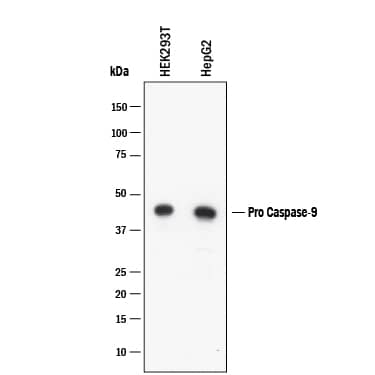Human Caspase-9 Antibody
R&D Systems, part of Bio-Techne | Catalog # AF8301

Key Product Details
Species Reactivity
Validated:
Cited:
Applications
Validated:
Cited:
Label
Antibody Source
Product Specifications
Immunogen
Val139-Asp330
Accession # P55211
Specificity
Clonality
Host
Isotype
Scientific Data Images for Human Caspase-9 Antibody
Detection of Human Caspase-9 by Western Blot.
Western blot shows lysates of HEK293T human embryonic kidney cell line and HepG2 human hepatocellular carcinoma cell line. PVDF membrane was probed with 1 µg/mL of Goat Anti-Human Caspase-9 Antigen Affinity-purified Polyclonal Antibody (Catalog # AF8301) followed by HRP-conjugated Anti-Goat IgG Secondary Antibody (Catalog # HAF017). A specific band was detected for Caspase-9 at approximately 46 kDa (as indicated). This experiment was conducted under reducing conditions and using Western Blot Buffer Group 2.Detection of Human Caspase-9 by Western Blot.
Western blot shows lysates of Jurkat human acute T cell leukemia cell line untreated (-) or treated (+) with 1 ug/ml Staurosporine (STS) for 2 hours. PVDF membrane was probed with 1 µg/mL of Goat Anti-Human Caspase-9 Antigen Affinity-purified Polyclonal Antibody (Catalog # AF8301) followed by HRP-conjugated Anti-Goat IgG Secondary Antibody (Catalog # HAF017). Specific bands were detected for Caspase-9 at approximately 46, 37, 35 kDa (as indicated). This experiment was conducted under reducing conditions and using Western Blot Buffer Group 2.Applications for Human Caspase-9 Antibody
Western Blot
Sample: Staurosporine-treated Jurkat human acute T cell leukemia cell line, HEK293T human embryonic kidney cell line, HepG2 human hepatocellular carcinoma cell line
Formulation, Preparation, and Storage
Purification
Reconstitution
Formulation
Shipping
Stability & Storage
- 12 months from date of receipt, -20 to -70 °C as supplied.
- 1 month, 2 to 8 °C under sterile conditions after reconstitution.
- 6 months, -20 to -70 °C under sterile conditions after reconstitution.
Background: Caspase-9
Caspase-9 (Cysteine-aspartic acid protease 9/Casp-9; also APAF-3, Mch6 and ICE-LAP6) is a 35-37 kDa member of the peptidase C14A family of enzymes. Casp-9 is an initiator caspase that is part of the intrinsic apoptosis pathway. It is widely expressed and is particularly important during development. Human proCaspase-9 is a 47-48 kDa, 416 amino acid (aa) protein and it contains one CARD region (aa 1-92) and catalytic residues at His237 and Cys287. Following mitochondrial disruption, cytochrome c is released from mitochrondria. Cytochrome c acts on APAF-1, which induces procaspase-9 dimerization. The act of dimerization activates proCasp-9, leading to either the activation of Casp-3, or the autocleavage of proCasp-9, generating a 35 kDa subunit (aa 1-315) and a 12 kDa subunit. Activated Casp-3 will also act on proCasp-9, generating a 37 kDa subunit (aa 1-330) and a 10 kDa subunit (aa 331-416). These subunits associate to form an active heterotetramer. Casp-9 has an alternative start site at Met84 and a deletion of aa 140-289 that generates a dominant negative, 31 kDa isoform. Over aa 1-134, human Casp-9 shares 81% aa identity with mouse Casp-9; over aa 139-330, human Casp-9 shares 73% aa identity with mouse Casp-9.
Additional Caspase-9 Products
Product Documents for Human Caspase-9 Antibody
Product Specific Notices for Human Caspase-9 Antibody
For research use only

